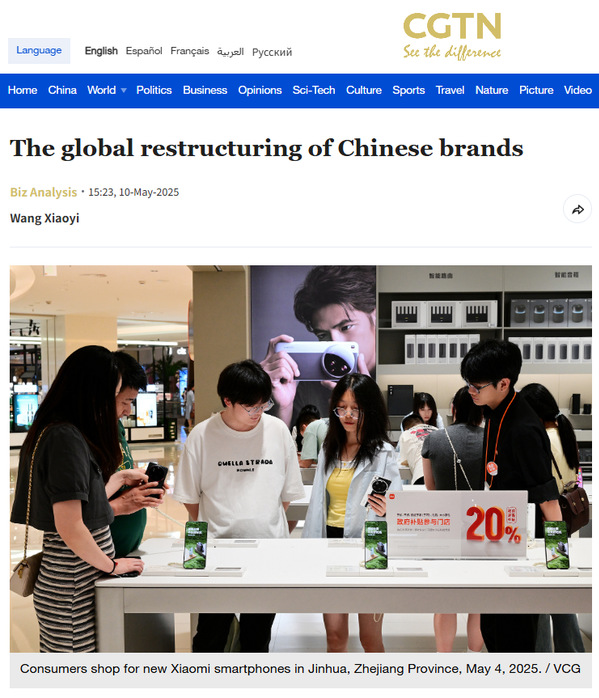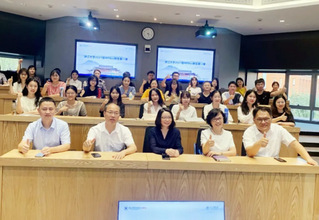
从“中国制造”到“中国创造”,是中国经济发展模式的深刻变革。其意义在于推动经济结构向高附加值产业升级,突破国际垄断、提升全球价值链地位,以技术创新驱动绿色可持续发展,促进人才向创新型转型。同时,通过技术输出和 “一带一路” 合作,为全球发展提供中国方案,还以科技赋能文化,重塑国家创新形象,彰显文化自信,为高质量发展和全球治理注入新动能。
近日,浙江大学管理学院教授、博士生导师王小毅在中国国际电视台(CGTN)官方网站上发表文章《从“中国制造”到“中国创造”:中国品牌的全球化重构》,诠释中国品牌崛起的底层逻辑及深远意义。

王小毅,浙江大学管理学院教授、博士生导师
从“中国制造”到“中国创造”:中国品牌的全球化重构
文/王小毅
5月10日中国品牌日不仅是国家叙事,更成为全球经济观察的重要窗口。《2024胡润品牌榜》揭示的不仅是数字跃升——抖音超越传统巨头位列第二,拼多多首入前五,比亚迪、华为分别以规模和行业增速改写竞争规则——更展现了一场静默革命:中国正从“世界工厂”转型为“全球创新策源地”,其品牌进化路径为后发经济体提供了全新范式。
中国品牌的突围本质是一场技术平权运动。比亚迪刀片电池迫使欧盟加速修订电动车安全标准;华为鸿蒙系统装机量海外占比27%,在拉美市场以“端-边-云”架构替代谷歌生态。这种“逆向创新”策略颠覆了传统技术扩散理论:发展中国家首次通过自主技术标准争夺全球规则制定权。
年轻世代的消费语言正在重写价值坐标。SHEIN将设计到交付周期压缩至7天(Zara为21天)。泡泡玛特盲盒在纽约MoMA商店月销破百万美元。完美日记“动物眼影盘”在TikTok引发Chinese Color Challenge话题,将《山海经》色谱转化为可触达的审美符号。中国品牌证明:文化输出不再是单向度的“东方奇观”展示,而是建立普世情感连接的能力。
“技术民主化+文化可及性”的组合,使得中国品牌成为“数字原住民”的价值共鸣器。中国的仿生机器狗正在快速进入全球市场,其开源生态正在吸引全球开发者。中国品牌在这一轮全球化中呈现出鲜明几个特征:首先是生态化。传音控股在非洲搭建的“智能机+移动支付+内容平台”生态,用户ARPU值较单一硬件销售有数倍的提升。其次是治理品牌化。商汤科技向东南亚国家输出中国的AI城市治理方案,其交通优化系统使雅加达通勤效率得到提升。
中国品牌的影响力得益于中国近十年推动的反向供应链革命。拼多多TEMU平台通过分布式仓储+AI选品,将供应链响应速度提升至“72小时全球达”。麦肯锡全球研究院测算:中国数字平台企业每1美元海外收入,可带动本土供应链企业0.7美元增值——这种“生态外溢效应”正在墨西哥蒙特雷、越南胡志明市等地复制,形成多中心创新网络。
这不仅是企业的胜利,更预示着全球商业文明的重构:当发展中国家首次在消费电子、新能源、AI等原创科技核心赛道掌握品牌影响力,全球化的叙事逻辑正从“中心-边缘”转向“多极化创新共同体”。
原版英文报道
China Brand Day on May 10 is not only a national narrative but also an important window to observe the global economy. The 2024 Hurun China Brand List has revealed more than just impressive numerical growth. As it is shown, Douyin has surpassed traditional giants to rank second, Pinduoduo has entered the top five for the first time, and BYD and Huawei are rewriting the rules of competition through scale and industry growth. It also demonstrates a silent revolution: China is transitioning from the world's factory to the global hub of innovation. The evolutionary path of Chinese brands offers a brand-new paradigm for latecomer economies.
The breakthrough of Chinese brands is essentially a movement advocating technological equity
The BYD blade battery has forced the EU to fast-track revisions of electric vehicle safety standards. HarmonyOS's overseas installations account for 27 percent of its total installations, replacing Google's ecosystem in Latin American markets. This reverse innovation strategy challenges the traditional theory of technology diffusion: For the first time, developing countries are using their own technology standards to vie for global rule-making power.
The consumption language of younger generations is rewriting value norms
SHEIN has compressed its design-to-delivery cycle to just 7 days (compared to Zara's 21 days). Pop Mart's blind boxes are generating over a million dollars in monthly sales at the MoMA Store in New York. Perfect Diary's Animal Eyeshadow Palette” has sparked a TikTok challenge, turning the color palette inspired by the Classic of Mountains and Seas into an accessible aesthetic symbol. Chinese brands have proven that cultural export is no longer a one-way display of Eastern spectacle but an ability to forge universal connections.
The combination of democratized technology and cultural accessibility has enabled Chinese brands to become value resonators for digital natives
China's robot dogs are rapidly entering global markets, with their open-source ecosystems attracting developers worldwide. Chinese brands have exhibited several distinctive features in this round of globalization. Firstly, they are ecosystem-driven. Transsion's smartphone + mobile payment + content platform”ecosystem built in Africa has multiplied ARPU (average revenue per user) compared to standalone hardware sales. Secondly, governance is also becoming branded. SenseTime has exported China's AI city governance solutions to Southeast Asian countries, where its traffic optimization systems have improved commuting efficiency in Jakarta.
The influence of Chinese brands is largely the result of the reverse supply chain revolution China has been promoting over the past decade
Pinduoduo's TEMU platform, through distributed warehousing and AI-assisted product selection, has shortened supply chain response time to achieve 72-hour global delivery. According to the McKinsey Global Institute, for every dollar of overseas revenue generated by Chinese digital platforms, an additional 70 cents is added to the value of local supply chain enterprises. This ecosystem spillover effect is being replicated in cities such as Monterrey in Mexico, and Ho Chi Minh City in Vietnam, creating a multi-center innovation network.
This is not just a victory for enterprises but also signals a restructuring of global commercial civilization. As developing countries begin to gain brand influence in core technology sectors such as consumer electronics, new energy, and AI, the narrative logic of globalization is shifting from a center-periphery model to a multipolar innovation community.
信息来源:CGTN





